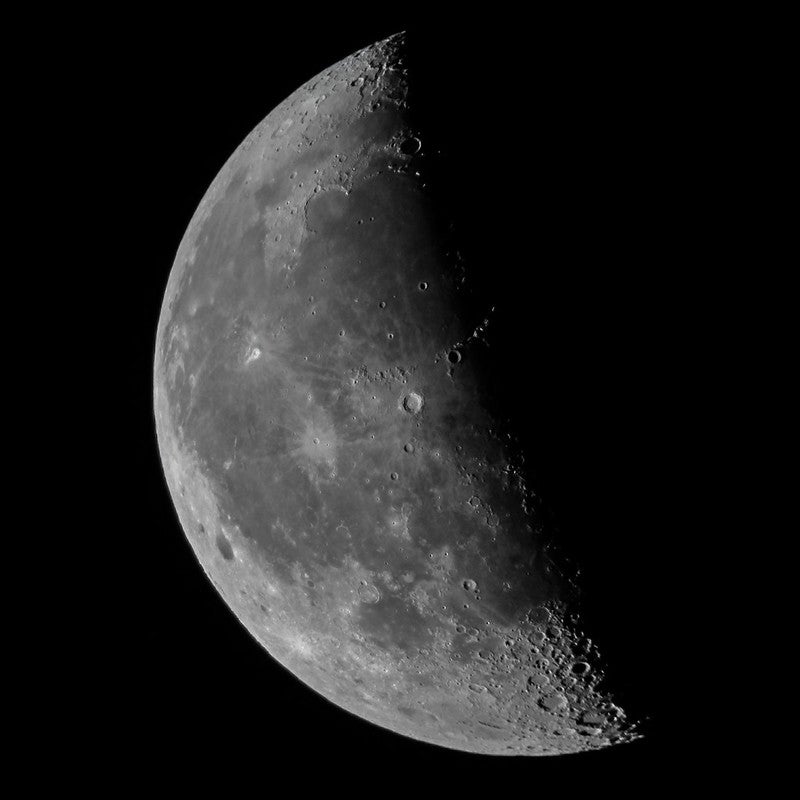
Friday, April 26
The Moon passes 0.3° north of the red giant star Antares in Scorpius today at 5 P.M. EDT. The pair is not visible in the early evening, rising in the hour before local midnight. You can catch them overnight tonight by looking southeast around 11:30 P.M. local daylight time — by that time, Antares is some 6° high and the bright gibbous Moon is nearly half that height.
The two will continue to rise into the early-morning hours of Saturday. They are now some 5° apart, with the Moon sitting to Antares’ southeast (lower left). The pair will sit due south around 3:30 A.M. local daylight time on Saturday morning.
While you’re waiting for them to rise, earlier on Friday evening you can enjoy the dark, Moonless window for observing fainter, deep-sky objects. Sitting above Leo the Lion in the south about two hours after sunset is the tiny constellation Leo Minor. Within this small star pattern lies NGC 3344, a beautiful face-on spiral galaxy that glows at magnitude 9.9.
You can find NGC 3344 about 6.3° east-northeast of 3rd-magnitude Zeta (ζ) Leonis in Leo. The galaxy also lies less than 2° due north of 5th magnitude 41 Leonis Minoris in southern Leo Minor. Through your scope, NGC 3344 will look like a soft, circular glow spanning about 7′. Larger scopes (8 inches or more) will show a brightening at its core. This galaxy is sometimes called the Sliced Onion Galaxy.
Sunrise: 6:06 A.M.
Sunset: 7:50 P.M.
Moonrise: 11:08 P.M.
Moonset: 7:18 A.M.
Moon Phase: Waning gibbous (93%)
*Times for sunrise, sunset, moonrise, and moonset are given in local time from 40° N 90° W. The Moon’s illumination is given at 12 P.M. local time from the same location.
Saturday, April 27
With the Moon rising just before midnight, there are again several hours of dark-sky viewing available after sunset. Let’s seek out the Ghost of Jupiter, often considered one of the springtime sky’s premier planetary nebulae. It’s also cataloged as NGC 3242.
Planetary nebulae consist of gas and dust blown off by aging red giant stars; as these stars evolve into white dwarfs, the debris remains, lit up by the white-hot remnant within for a short time. Planetary nebulae are fleeting, only lasting some 10,000 to 20,000 years before fading away.
The Ghost of Jupiter is so named because it spans roughly the same size as the gas giant planet in our sky: about 16″ in diameter. Its compact, spherical shape combined with its magnitude of 7.8 make it relatively bright and easy to observe. To most observers, and particularly in larger scopes, it looks distinctly blue-green.
The nebula is located in Hydra, which sits in the south an hour or two after sunset. You can find the Ghost of Jupiter by looking about 6.5° west-southwest of 3rd-magnitude 4 Crateris in nearby Crater the Cup.
Sunrise: 6:04 A.M.
Sunset: 7:52 P.M.
Moonrise: 11:06 P.M.
Moonset: 8:00 AM
Moon Phase: Waning gibbous (86%)
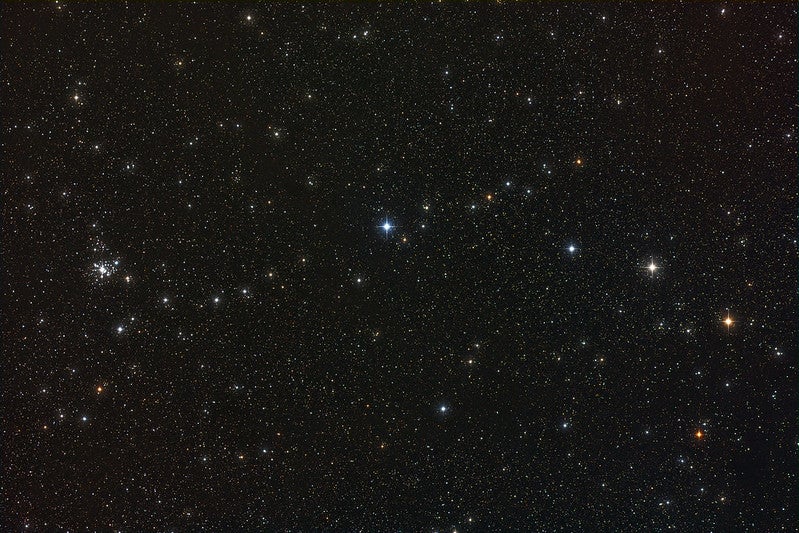
Sunday, April 28
Mars passes 0.04° south of Neptune at midnight EDT. Neither is visible at that time, as they rise a short time before sunrise — so tune in tomorrow, when we’ll catch them in the early-morning sky on Monday.
Tonight, let’s instead focus on the northern constellation Camelopardalis, which lies to the left of the North Star this evening. (Camelopardalis is a circumpolar constellation, meaning it appears to rotate around the North Star from northern locations, rather than rising in the east and setting in the west.)
Let’s first look for NGC 1502, a 6th-magnitude open cluster about 9° south of magnitude 4.6 Gamma (γ) Camelopardalis. This beautiful ball-shaped grouping of young stars is readily visible in binoculars as a soft glow, while telescopes will begin to pull out individual members as points of light.
NGC 1502 forms the “base” of a famous asterism called Kemble’s Cascade, which resembles a flow of water cascading down into a pool. The star cluster is often envisioned as the spray at the end of the line. From NGC 1502, you can trace the rest of the Cascade “backwards” to the source along 14 or so 7th- to 9th-magnitude stars to the northwest. NGC 1502 sits at the southeast end of the Cascade, which stretches about 2.5° in total.
Sunrise: 6:03 A.M.
Sunset: 7:53 P.M.
Moonrise: 12:11 A.M.
Moonset: 8:53 A.M.
Moon Phase: Waning gibbous (79%)
Monday, April 29
Now let’s home in on Mars and Neptune, some 12′ apart in the pre-dawn sky. Mars is magnitude 1.1, visible to the naked eye in a dark sky, but Neptune is so faint — magnitude 7.8 — you’ll need at least binoculars or a small scope to view this pairing. You’ll absolutely be able to catch both planets in the same field of view, even using the higher magnification of a telescope. It’s a great opportunity to view planets near and far through the eyepiece at the same time — Mars is now 184 million miles (296 million kilometers) from Earth, while Neptune is a whopping 2.85 billion miles (4.59 billion km) away.
The pair of planets rises around 4:30 A.M. local daylight time and an hour before sunrise, they are nearly 6° high in the east, located to the lower left of Saturn, which glows at roughly the same magnitude as Mars but stands a bit higher in the sky about 10.5° high at this time.
Mars will be easy to locate, then simply look through your optics to search for tiny, faint Neptune now sitting to the Red Planet’s west. Mars spans 5″ and will look distinctly orange-red, while Neptune is just 2″ across and will look more like a faint, “flat” star compared to Mars. Can you tell, though, that Neptune is a round disk, rather than a pointlike star? Having Mars in the same field of view for comparison may help.
Sunrise: 6:02 A.M.
Sunset: 7:54 P.M.
Moonrise: 1:08 A.M.
Moonset: 9:56 A.M.
Moon Phase: Waning gibbous (69%)
Tuesday, April 30
Tonight, let’s look for a famous variable star in Leo the Lion: R Leonis. Leo is still 70° high in the south an hour after sunset. Look for the Lion’s brightest star — this is magnitude 1.4 Regulus, which marks the big cat’s heart. R Leonis is nearby, some 5° west of Regulus.
Because it is currently about magnitude 6.5, you’ll need binoculars or a small scope tonight to easily make out R Leo. It should look reddish to your eyes — it’s a cool, aging red giant star that is also classified as a long-period variable. Over the course of 312 days, R Leo transitions between magnitude 5 and 10.5 and back again. Its variability was first discovered in 1782, making it the fourth long-period variable ever identified.
R Leo recently reached its maximum brightness late last month and is now starting to ever-so-slowly fade back toward its minimum. If you’re particularly interested in following the star’s progress, you can visit the American Association of Variable Star Observers’ website and download an observing chart for R Leo here.
Sunrise: 6:01 A.M.
Sunset: 7:55 P.M.
Moonrise: 1:56 A.M.
Moonset: 11:06 A.M.
Moon Phase: Waning gibbous (59%)
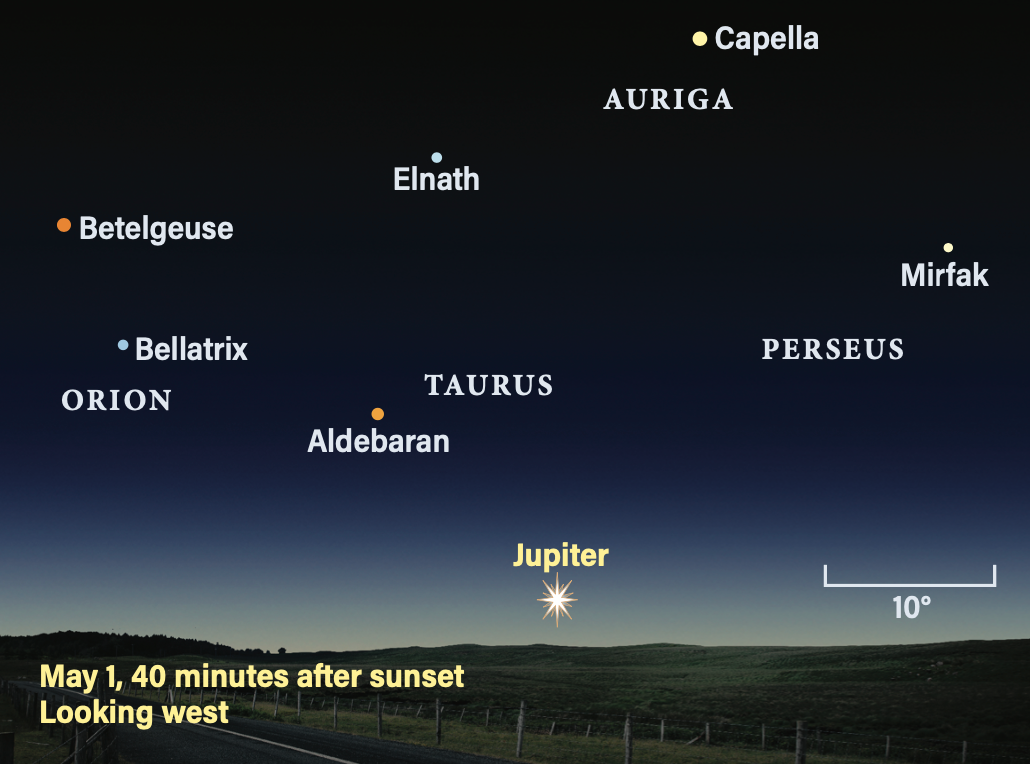
Wednesday, May 1
The Moon reaches Last Quarter at 7:27 A.M. EDT this morning. This lunar phase occurs when the Moon rises after midnight and lingers in the early-morning sky, offering early risers a chance to view our satellite before and after sunrise (though take extreme care when observing through optics after the Sun clears the horizon). Clearly visible now is the western portion of the nearside, dominated by Mare Imbrium and Oceanus Procellarum.
For those who prefer to observe in the evening, now is the time to catch your last glimpses of Jupiter, as the mighty planet is setting earlier and earlier each day. Tonight, the gas giant sets in the west within about an hour of the Sun, so you’ll want to start observing as soon as possible after sunset. Fortunately, the planet is bright at magnitude –2, allowing observers to easily pick it out of the twilight sky. Some 20 minutes after sunset, Jupiter is about 6° high, with Uranus (magnitude 5.9) to its lower right. Unfortunately, the distant ice giant is likely too faint to see in the glare of the fading light, even with binoculars or a telescope.
Nonetheless, your optics should show some detail on Jupiter’s large disk, particularly the colorful cloud bands straddling the equator. Depending on your observing location (and time zone), the Great Red Spot may be rotating onto the disk as well. Those on the East Coast may also catch the tail end of a transit of Io and its shadow — the moon moves off the disk around 8:30 P.M. EDT, while the shadow follows some 20 minutes later. After that, Io sits west of the planet near the limb, while Ganymede and Callisto (farthest out) sit farther west. Europa sits alone to the gas giant’s east.
Sunrise: 5:59 A.M.
Sunset: 7:56 P.M.
Moonrise: 2:36 A.M.
Moonset: 12:20 P.M.
Moon Phase: Waning crescent (48%)
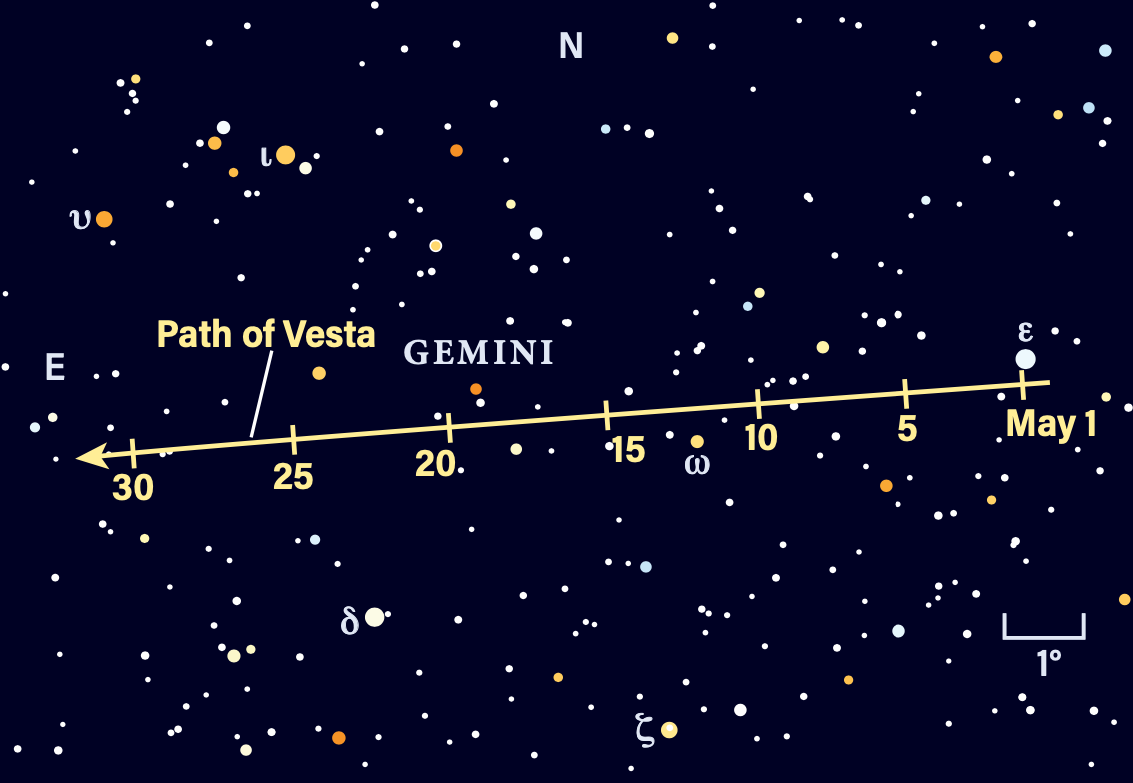
Thursday, May 2
Asteroid 4 Vesta is passing close to magnitude 3.1 Epsilon (ϵ) Geminorum tonight. You’ll find the magnitude 8.3 minor planet about ½° southeast of this star — an easy signpost to spot one of the main belt’s largest and most massive members. In fact, according to NASA, Vesta comprises some 9 percent of the total mass of the asteroid belt!
You’ll find Gemini in the west, about 40° high an hour after sunset. The constellation will slowly set as time goes by, so opt to view it earlier in the evening. The mighty hunter Orion is already nearing the horizon at that time, as the wintertime constellations begin to disappear from the sky while the spring and summer constellations are rising in the east.
Vesta will continue east through Gemini throughout the month of May, only dimming by 0.1 magnitude and making an excellent post-sunset target. For the most part, it will be one of the brightest points of light in any given field of view, and tonight you can even see it move slightly against the stationary backdrop of faraway stars if you’re able to observe for two or three hours. Note that the motion will be subtle, so take images or make sketches periodically to best note the change.
Vesta sits directly below Gemini’s two brightest stars as the Twins set: Castor (on the right/west) and Pollux (on the left/east) mark the brothers’ heads. Castor is slightly fainter (magnitude 1.6, compared with Pollux’s magnitude 1.2), but is a stunning double star that can be readily split with most scopes.
Sunrise: 5:58 A.M.
Sunset: 7:56 P.M.
Moonrise: 3:09 A.M.
Moonset: 1:36 P.M.
Moon Phase: Waning crescent (36%)
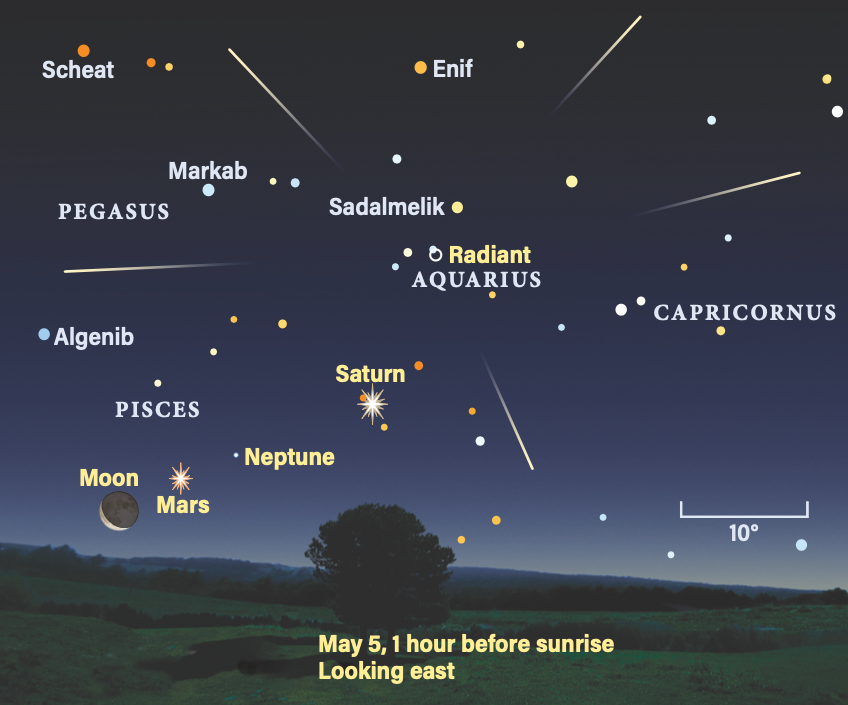
Friday, May 3
The Eta Aquariid meteor shower peaks in just two days, but early this morning there could be a brief increase in the number of meteors visible in the pre-dawn sky. That’s because early today, our planet is projected to move through the trail of debris left by Halley’s Comet when it passed through the inner solar system in 985 B.C.E. This famous comet is the parent of the Eta Aquariids, meaning its old debris trails are the source for these meteors. Because those trails drift with time in the solar wind, they can become slightly offset from each other, causing increases in the number of meteors on days other than the predicted peak. So, if you’re up early this morning, look east an hour or two before sunrise, when the radiant in Aquarius is well above the horizon. You can use the chart above to aid in finding it to the upper right of Saturn, which shines at magnitude 1 and is one of the brightest objects in this part of the sky. (Note that the chart above is for May 5, so the position of the Moon will be different — keep reading for more.)
Speaking of Saturn, the Moon passes 0.8° south of Saturn at 7 P.M. EDT. Early this morning when the two are visible well above the horizon an hour or so before sunrise, the waning Moon stands just under 8° to the right of Saturn, closing in. Again, as you can see from the chart above, which depicts the sky in two days’ time, the Moon will continue moving quickly across the sky and stand to Saturn’s left after it passes the planet.
Also at 1st magnitude, Mars lies farther east along the ecliptic in Pisces, lower to the horizon. The Red Planet has now left Neptune behind and is 3° to the distant ice giant’s east. (You can still spot Neptune, but remember you’ll need binoculars or a telescope and will need to do so before the sky starts to brighten.)
Late tonight, the tiny dwarf planet Pluto stands stationary against the background stars of Capricornus at 11 P.M. EDT.
Sunrise: 5:57 A.M.
Sunset: 7:57 P.M.
Moonrise: 3:37 A.M.
Moonset: 2:50 P.M.
Moon Phase: Waning crescent (26%)

Sky This Week is brought to you in part by Celestron.









